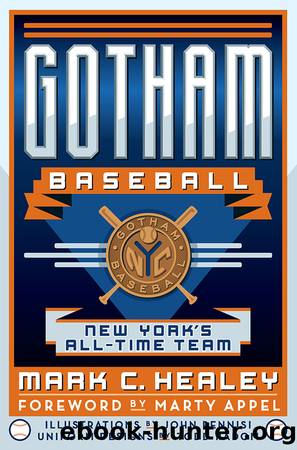Gotham Baseball by Healey Mark C.;Appel Marty;Pennisi John;Radom Todd;

Author:Healey, Mark C.;Appel, Marty;Pennisi, John;Radom, Todd;
Language: eng
Format: epub
Publisher: Arcadia Publishing
Published: 2020-08-15T00:00:00+00:00
The Detroit Tigers thought enough of Hubbell to purchase his contract in 1926, but in the left-handerâs first training camp, the screwball he had developed to turn him into a real prospect nearly doomed his career.
Author Lang Leave once wrote, âYou can create something that is pure genius, but you have to get your timing right.â In Hubbellâs case, this rings particularly true.
Spring training 1926: The Tigers manager is Ty Cobb, the same Cobb who would be inducted into the inaugural class of the Baseball Hall of Fame in 1936 with Mathewson, Walter Johnson, Babe Ruth and Honus Wagner. It is likely that Cobb remembered Mathewsonâs words, or at least held the belief that the screwball was bad for the arm, because he forbade Hubbell to throw the pitch.
Years later, former Tiger pitcher Bill Moore told author Richard Bak (Cobb Would Have Caught It: The Golden Age of Baseball in Detroit) that he recalled Cobb approaching Hubbell at camp. âCarl Hubbell was in the Tigersâ farm system at the same time I was,â recounted Moore. âCarl and I knew each other. We pitched against each other in the International League. Later, of course, he had all those great years with the Giants. Threw that screwball, you know. That was his bread-and-butter pitch. You know what Cobb told him to do with it? âGet rid of that damn pitch.ââ
For two years, robbed of his best pitch, Hubbell slumped, first in Triple-A Toronto in 1926. Then he was demoted to Class-B ball, where he pitched well (14-7). But the Tigers had seen enough, selling him to Beaumont in the Texas League.
Moore said Hubbell told him, âThe best thing that ever happened to me was when that son of a bitch [Cobb] released me.â
Enter John âMugsyâ McGraw.
Remember that whole timing thing? New York Giant scout Dick Kinsella (no relation to Shoeless Joe author W.P. KinsellaâI looked it up) also happened to be a delegate to the Democratic National Convention in Houston and took in a Texas League game, which just happened to be one in which Hubbell was impressive, as he had been throwing his screwball again.
As recounted by Frank Graham in The New York Giants, Kinsella warned McGraw that while the twenty-five-year-old left-hander had been impressive, he threw a screwball.
McGraw, who apparently hadnât read Pitching in a Pinch, replied that his star Mathewson had thrown a fadeaway and âit never hurt his armâ and instructed Kinsella to pay $30,000 for the rights to Hubbell, which was then a record for the Texas League.
Under McGraw, Hubbell became a reliable starter, from 1928 to 1932 averaging 15 wins, 8 losses and a 3.11 ERA. In 1932, McGraw retired from managing after the team started 17-23, and first baseman Bill Terry took over the team.
McGraw had given Hubbell his shot and had been a calming force during his rookie season, but it was under Terry that Hubbell became the best pitcher in baseball.
In a 1982 oral interview with Carl Hubbell conducted by SABRâs Oral History committee, Hubbell discussed the good and bad of McGraw.
Download
This site does not store any files on its server. We only index and link to content provided by other sites. Please contact the content providers to delete copyright contents if any and email us, we'll remove relevant links or contents immediately.
Machine Learning at Scale with H2O by Gregory Keys | David Whiting(4027)
Never by Ken Follett(3736)
Liar's Poker by Michael Lewis(3342)
The Ultimate Backcountry Survival Manual by Aram Von Benedikt; Editors of Outdoor Life;(3204)
Will by Will Smith(2754)
The Partner by John Grisham(2330)
Can't Hurt Me: Master Your Mind and Defy the Odds - Clean Edition by David Goggins(2103)
Friends, Lovers, and the Big Terrible Thing by Matthew Perry(2092)
Taste by Kris Bryant(1824)
HBR's 10 Must Reads 2022 by Harvard Business Review(1750)
A Short History of War by Jeremy Black(1739)
Never Finished: Unshackle Your Mind and Win the War Within by David Goggins(1615)
515945210 by Unknown(1579)
The Arm by Jeff Passan(1557)
A Game of Thrones (The Illustrated Edition) by George R. R. Martin(1538)
The Dodgers by Schiavone Michael;(1500)
The Yogi Book by Yogi Berra(1464)
443319537 by Unknown(1444)
1942266391 (N) by Monte Francis(1401)
